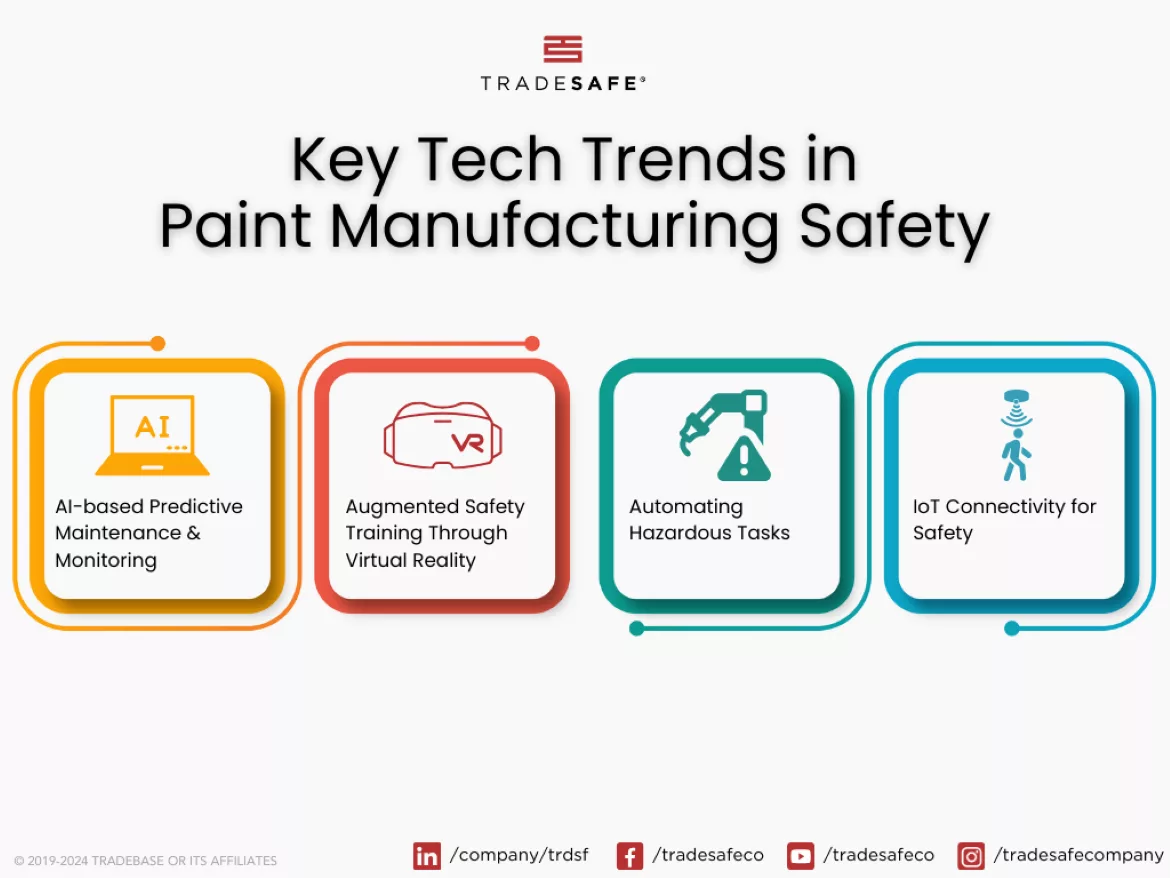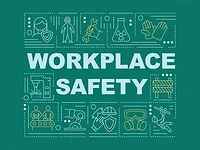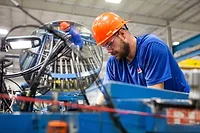Tech Trends Re-Shaping Safety in Paint Manufacturing

Image courtesy of TRADESAFE.
Paint and coatings are used in manufacturing, construction, and other various industries, not just for aesthetic purposes but also to protect various materials from corrosion and damage. Due to this demand, it’s no wonder that the industry is rapidly growing. According to market research, a compound annual growth rate of 6% is predicted for this industry by 2030. With this growth comes the need to evolve and keep up with technology to remain profitable. Aside from improving productivity, technology should also be used to improve worker safety. The employees are the company’s best asset and a safe and satisfied workforce is a boost to the bottom line.
Importance of Safety in Paint Production
The production of paint involves numerous health and safety hazards, including exposure to toxic chemicals and organic substances, usage of grinding and mixing equipment, slips and falls, the risks of combustion due to flammable paint components, and electrocution from faulty equipment. Studies have shown that a high percentage of workers are aware of these hazards but half of them take for granted basic safety protocols like wearing personal protective equipment (PPE). Also, not all employees undergo formal safety training upon onboarding or as a recurring training program. These factors greatly affect workplace safety and the well-being of the workforce.
The advent of modern technology brings with it limitless possibilities on how to enhance workplace safety in the paint manufacturing industry. This includes efficient assessment and monitoring of hazards, encouraging training, and adherence to safety regulations.
Key Tech Trends in Paint Manufacturing Safety
In this era of technological innovations, significant progress has been made in terms of solutions and concepts to prevent accidents, injuries, and health concerns in the paint production industry. With the use of artificial intelligence, augmented reality, and automation, minimizing workplace hazards is made easier.
AI-Based Predictive Maintenance & Monitoring
Predictive maintenance is an advanced approach that uses artificial intelligence to reduce the probability of errors occurring in the system. It plays a crucial role in preventing accidents in the workplace by detecting potential hazards early on and mitigating them, resulting in fewer incidents of machinery and equipment malfunction that may cause injuries. As opposed to traditional reactive maintenance, wherein a problem is fixed after it occurs, predictive maintenance can identify early warning signs allowing for proactive action to be taken. This minimizes the occurrence of emergency downtimes and improves equipment reliability and lifespan.
Augmented Safety Training Through Virtual Reality
The innovation of virtual reality in safety training has revolutionized the process by protecting workers from being exposed to actual hazards during training. They are trained using a simulation of workplace risks that will allow them to react naturally and improve their reflexes. This type of training is easier to carry out, allowing more workers to undergo training. When workers have formal safety training, they are equipped with the necessary knowledge to protect themselves from injury and harm. Frequent retraining is also encouraged to keep them updated on safety measures as they evolve.
Training for new technologies is critical to help workers fully understand how to use them properly. Wrong usage and application of new technologies result in errors which then raises concerns about their efficacy.
Automating Hazardous Tasks
Automation has changed the paint manufacturing landscape by improving quality, productivity, and more importantly, safety. Unlike humans, robots can operate for long periods of time without tiring. This augments human output without exposing them to the health risks of being overworked.
In the paint production industry, hazardous tasks such as mixing and grinding can be delegated to collaborative robots, minimizing human exposure to chemicals and other harmful paint components. Heavy lifting, pushing, or pulling throughout the manufacturing process can be done by robots to reduce strains, sprains, and musculoskeletal injuries. Although investing in automation does not come cheap, it is worthwhile in maintaining high standards for quality and efficiency in production.
IoT Connectivity for Safety
Internet of Things (IoT) drives the adoption of data-driven solutions to improve operational efficiency, sustainability, and safety. Through IoT-based technologies, companies can gather and analyze data for real-time insights into the production process. It can also disseminate information with regard to safety measures and warnings in the event of emergencies.
In the paint manufacturing industry, IoT paves the way to optimize the production process through sensors and connected devices. Similarly, sensors can also be used in real-time monitoring of the manufacturing facility to enable a detection and warning system for fire hazards, and unhealthy toxin levels in the air, and even to alert for improper PPE use on the factory floor.
Challenges in Implementing New Safety Technologies
Introducing new changes in an organization is often met with challenges and resistance. Especially if these changes require learning a new technology. But to move ahead from competition, change is essential. Factors that pose common challenges in implementing innovations lie in employee engagement, company resources, as well as in communication and training.
Poor Employee Engagement
The fear of robots and technology replacing humans in the workplace has created resistance from workers to be open to new technology. They do not fully understand the advantages of using these advancements to make their workplace safer. Forming a team composed of people from various roles and capacities within the organization to share their knowledge of new safety developments is a collaborative approach to fostering a strong safety culture.
Lack of Company Resources
Investing in new technology costs a lot of money which can put a strain on company resources. The best way to keep up is to conduct a thorough risk assessment and consult with employees to determine which safety technology can best benefit the organization. In the long run, investing in safety can translate to savings compared to hefty violation penalties.
Communication and Training Gap
Effective communication is crucial in the proper implementation of new safety technology. Everyone must be on board and on the same page. There should be no knowledge gaps when it comes to benefits, expectations, and instructions. Most importantly, adequate training and support should be provided to employees who would be using the new technologies. Feedback from first-hand experience of workers in the usage of new devices should be included in the training as well to make it more comprehensive and practical.
Adapting to technological advancements for enhanced safety in the paint production industry allows paint manufacturers to be more resilient and compliant. Ultimately, it’s about ensuring a safe and healthy environment for their employees to thrive in since these new technologies are more than just a passing trend, they are the future of workplace safety and are definitely here to stay.
For more information, click here.
Looking for a reprint of this article?
From high-res PDFs to custom plaques, order your copy today!








